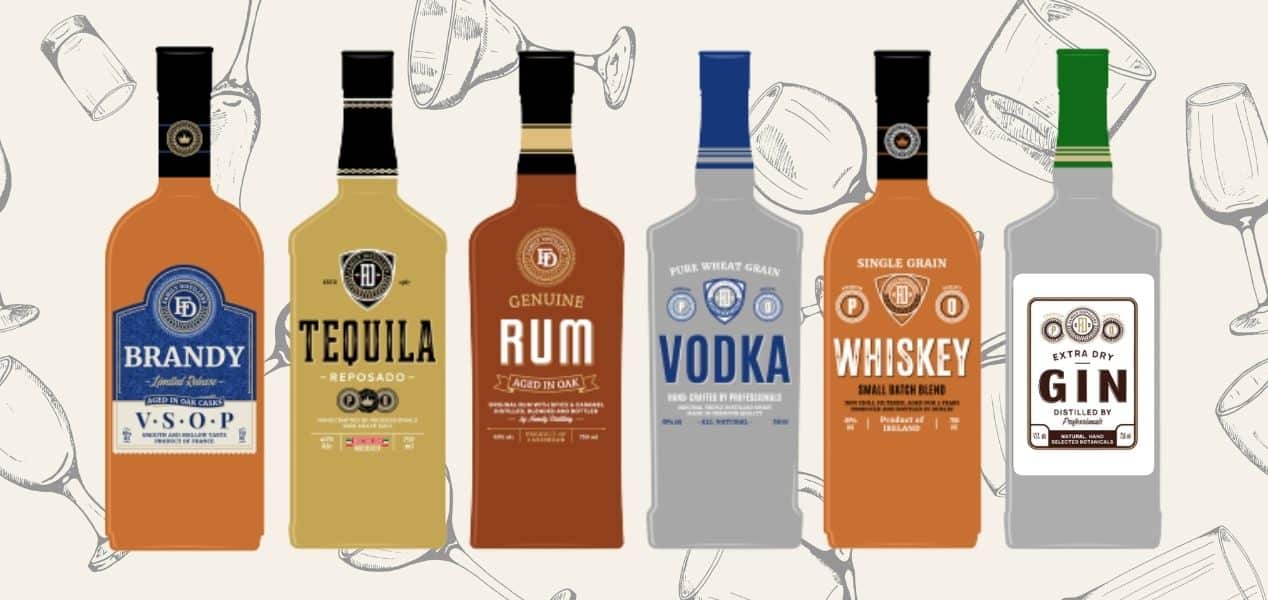Different types of alcohol can fall into any number of categories, so it can be difficult to make out what counts as liquor and what doesn’t.
From beer to wine to whiskey to rum, humans have been brewing and distilling alcohol for almost as long as we’ve been around. So it’s no surprise that there are hundreds, if not thousands, of different methods of producing and aging booze.
While finding out which beverage is and is not a liquor means hours of research, knowing what the classifications of liquor are is much easier. In fact, for something to be classified as liquor, it doesn’t need to do much.
In this article, we’ll discuss what makes a liquor, what the methods and processes of production are, and its end result.
We’ll also look at various types of liquor, their history, and what makes them unique.
Liquor Varieties
What is Liquor?
If we’re going to discuss the various style and types of liquor, we first need to understand what liquor is and where it differentiates from other types of alcohol.
Colloquially, people often refer to all alcohol as liquor, but the technical definition is more specific.
All alcohol begins with fermentation. Ingredients like corn, barley, grapes, potatoes, and many others are mashed together into a “wort”. The natural yeasts in the skins and husks of the ingredients then begin fermenting.
The yeast in the mash breaks down sugar and complex carbohydrates and produces alcohol and CO2. Some alcoholic beverages are naturally carbonated, like craft beer and champagne. The carbon dioxide released during fermentation is what makes these drinks fizzy.
For low-alcohol beverages, this is where the process stops. The wort is filtered, strained, and bottled. But liquor requires one more step: distillation.
Liquor needs to be distilled, often more than once. Distillation means heating the brew to separate the water from the alcohol. The wash is kept at a low temperature which evaporates the alcohol and not the water.
The alcohol is then collected and either aged in wooden casks or distilled further.
Vodka
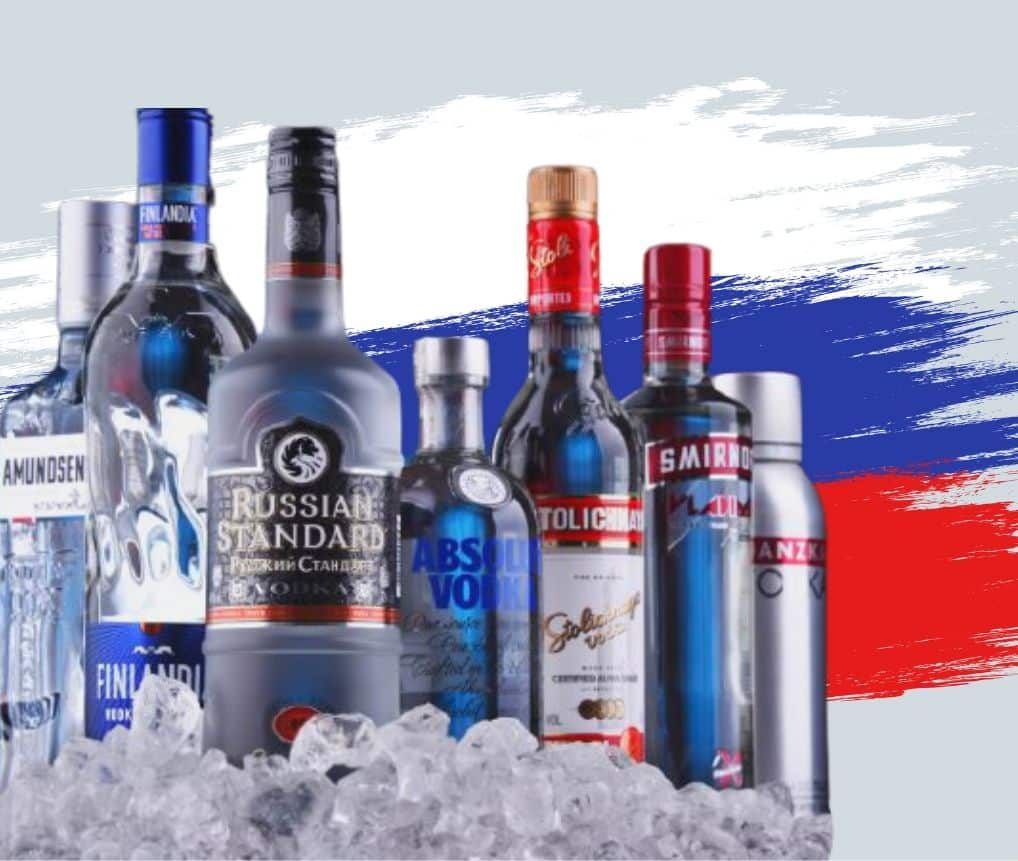
History
Some misconceptions about vodka are that it’s made from potatoes and it comes from Russia. While these notions are at least partially correct, Vodka’s history is more complicated than that.
Vodka gets its name from “Voda,” the Slavic word for water. Historians suggest that Vodka was made in many areas of Northern and Eastern Europe – sometimes referred to as the “Vodka Belt.”
Each of these cultures has its own versions of vodka, making it out of different ingredients and surrounding it with different cultural practices.
How it’s made
Potatoes being used as a primary ingredient in the brewing mash is also a relatively new change. Before, the mash consisted mostly of cereal grains. But as grains got more and more expensive, some distilleries made a switch to potatoes to keep their costs down.
Vodka is typically distilled at least three times, although some brands go as high as six. Each time the alcohol is distilled, more impurities are left behind which results in purer alcohol. Additionally, some distilleries then filter the distillate through charcoal.
Vodka is distilled to around 90% alcohol (180 proof) before filtered water is added to dilute the solution to between 35-50% ABV (70-100 proof).
Some regions have laws around what is and isn’t considered vodka. The EU established that vodka must contain a minimum of 37.5% ABV (75 proof). In the US, it must be at least 40% alcohol.
The repeated distillation process when making vodka removes almost all of the impurities from the beverage. This is what causes vodka to be a clear, odorless spirit. Removing any impurities is what gives vodka its neutral taste, making it ideal for cocktails.
Another reason to remove all of the flavors and impurities is the after-effects on the drinker. The heavy particles that give spirits like rum and brandy their characteristic flavors are the same ones that contribute to your hangover the next morning.
Whiskey

History
Whiskey, or whisky, is a distilled spirit made from grain mash that is made all over the world. It originated in Scotland and Ireland as a medicinal brew: “aqua vitae” – the water of life. There are records of whiskey distillation dating back as far as the late 15th century.
It soon evolved from being used purely for medicinal treatments for colic or pox into the art that it is today.
There is considerable confusion around the spelling of the word. Should it be spelled with or without the “E”? The answer is quite simple. “Whiskey” is made in Ireland and parts of the US, although American spelling is sometimes interchangeable. “Whisky” is made everywhere else.
How it’s made
Whiskey is one of the most varied types of liquor made. It encompasses many different styles and brands of alcohol, including bourbon, scotch, rye, single malts, blends, and more.
Each of these types has set practices determining which ingredients they can use, the distillation process, and alcohol content. The effect of the different practices makes a huge difference on the finished product. Some whiskies are smoky and spicy, others smooth and sweet.
All whiskey begins with the mash. This can be made up of corn, wheat, barley, or rye.
Once it has fermented and produced the desired amount of alcohol, the mash is filtered and distilled in copper stills. The copper removes any sulfur from the spirit which would give it an unpleasant, eggy taste.
The spirit is distilled to between 60-80% ABV (120-160 proof) before it is left to age in wooden casks. The cask used has a major effect on the taste of the spirit. Some distillers use charred oak or old sherry casks to give it a particular flavor.
Whiskey is left to age in casks for at least three years. Some whiskies are sold at cask strength which means they need to be diluted to bring out the best flavors.
Typically, whiskey has a very smoky nose that it picks up from barrel-aging. It has a spicy and peaty flavor with hints of honey and cinnamon.
Popular brands:
Rum
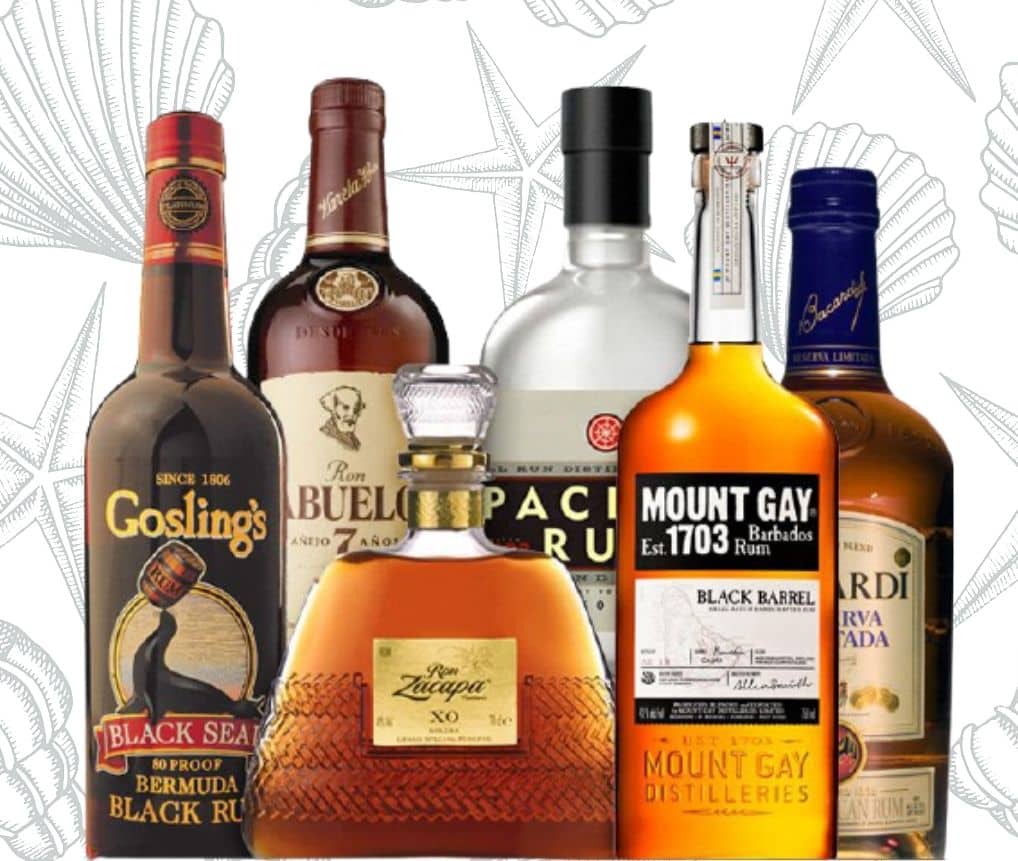
History
Originating in the Caribbean Islands, rum is one of the most popular liquors on the market today. Despite its popularity, rum is often unfairly seen as a cheap alternative to other, more expensive spirits.
In truth, there is as much variety in the types of rum as there is in prestige spirits like whiskey and brandy.
The origins of the word “Rum” are still unclear. Some believe it came from the word “rumbullion,” a drink made from boiled cane sugar. It’s hard to say when rum was first made, but there are historical texts which indicate it was enjoyed in Europe at least 700 years ago.
How it’s made
Unlike most other liquors, rum is not brewed from cereals or grains. Distillers use molasses or sugar cane juice to start their brew off. Molasses is a by-product of sugar production, so rum is a sweeter spirit than others.
Brewers add yeast to the mix because there is not enough occurring naturally to begin the process of fermentation. Once the mash has fermented for about three weeks, it is strained and distilled.
There are very few standards when it comes to fermenting and distilling rum. Each distillery has its own recipes and procedures that it follows to produce the drink. If you’re looking into specifics of rum production, each distillery will be unique.
Light rum is clear and has a neutral flavor. It is bottled immediately after distillation to maintain its color. Light rum is often used in cocktails or mixers.
Dark rum is a rich brown color, similar to cherry soda. It gets its color from being aged in wooden barrels. Some distillers use old bourbon barrels to give the drink more flavor. It can be used in cocktails but is also enjoyed neat or with ice.
Spiced rum, like Bacardi or Talisker, has added ingredients to change the taste of the drink. Brewers add vanilla, honey, cinnamon, nutmeg, or any number of herbs and spices to the spirit which gives it a sweeter, fresher flavor.
Some spiced rums are made to be used in cocktails. Others are best drunk neat.
Brandy

History
The production of brandy began in Europe sometime around the 16th Century. One story is that two wine merchant brothers discovered that they could reduce the tax they paid on transporting alcohol across borders.
The tax was calculated on the volume of wine. So the siblings distilled wine before they got to the border, which reduced the number of cases they would have to pay fees on. Once they were on the other side of the border, they added water back to the barrels.
There is also reason to believe that distilling wine was a preservation method used in monasteries to keep their wine drinkable for longer.
At some point, people figured out that they could drink the distillate as it was, rather than diluting it back down.
Learn more about the differences between brandy and whiskey.
How it’s made
Nowadays, not any old wine can be turned into brandy. Distillers use a specific recipe of grapes and yeast to produce wine. This is then distilled in aged in oak barrels for at least three years before being bottled.
Brandy from Portugal and Spain tends to use the fractional blending method. This means that distilled brandy is added gradually to the aging barrel so that the finished product is a mixture of ages.
Cognac
One of the most expensive and exclusive types of brandy is cognac. Cognac comes from the wine-growing region of Cognac, Charente in France. Like with champagne, cognac is protected by AOC protections.
This means that only brandy made of specific grapes distilled in the region and aged for a minimum of two years in French oak barrels from Troncais qualify as cognac. The strict regulations and quality control are part of what makes cognac so expensive. E.g. Hennessey VSOP.
Gin
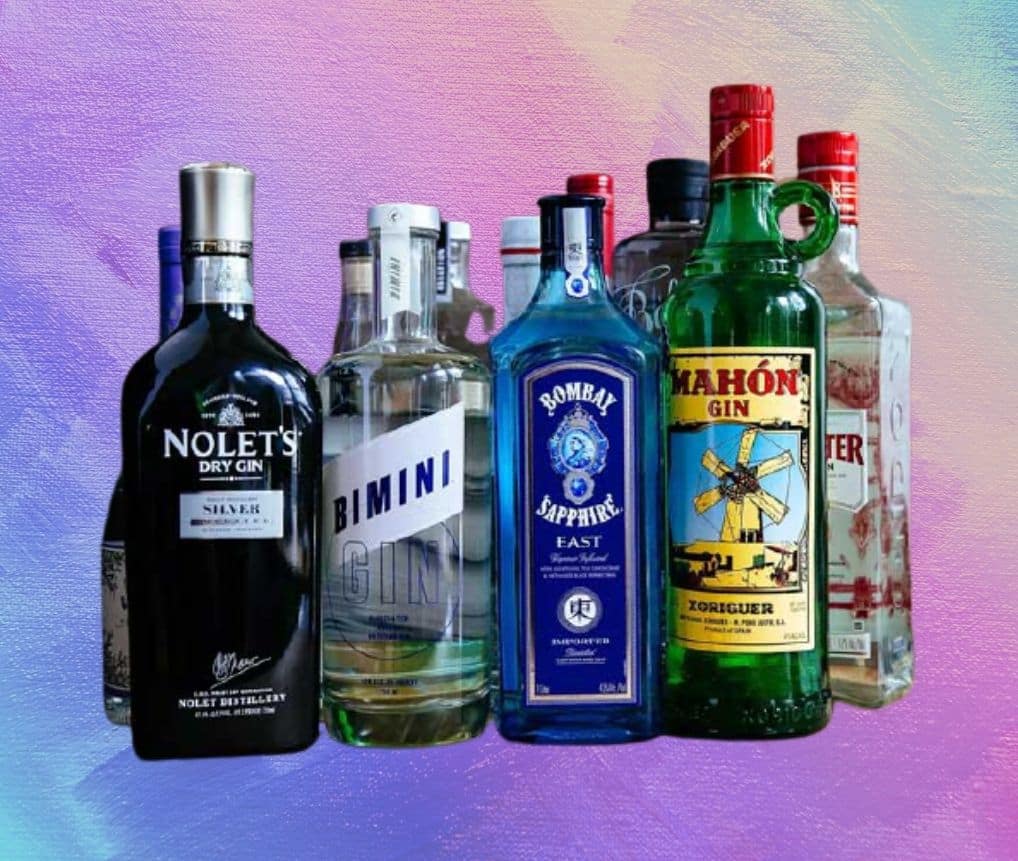
History
Gin – or Mother’s Ruin, as it’s sometimes referred to – has been in production in Europe for at least 800 years. It derives its name from the Dutch word “jenever,” from the Latin “Juniperus,” meaning juniper.
How it’s made
It’s produced similarly to vodka. A mash of grains, corn, or potato is fermented and distilled into a highly alcoholic solution, normally around 70% ABV (140 proof).
Once it has reached the desired potency, brewers add spices and aromatics to the liquor. Juniper berries are the most common additive in gin, but ingredients like orange peel, aniseed, and cinnamon are all common in gin making.
Once the aromatics have had a chance to steep in the alcohol, the spirit is then distilled further. Depending on the desired dryness of the liquor – that is, how sweet it is – the final product is anywhere between 90-100% alcohol.
Distilled water is added to dilute the spirit to a more palatable level. Gin is unaged, so it is bottled directly from the distilling pots.
There are a variety of distilling methods, from pot to column stills to everything in between. Each of these methods has a lasting effect on the finished product. Some result in sweeter, more rounded spirits while others produce a dry gin.
London gin, sometimes called London Dry, is a classification for superior gins. To be classified as a London gin, distillers are given strict parameters that their liquor must adhere to. e.g. Tanqueray Gin.
No artificial flavors or sweeteners are allowed to be added. There is also a strict limit on the amount of methanol present in the liquid (>0.05g methanol per liter). The reduced methanol content means a less intense hangover and less stress on your body.
Gin is most commonly consumed with a tonic mixer, but it is also used in cocktails. Gimlets, Negronis, and Tom Collins are all classic gin cocktails that bring out the aromatic juniper flavor.
A gin of high quality can even be sipped neat or on the rocks.
Tequila
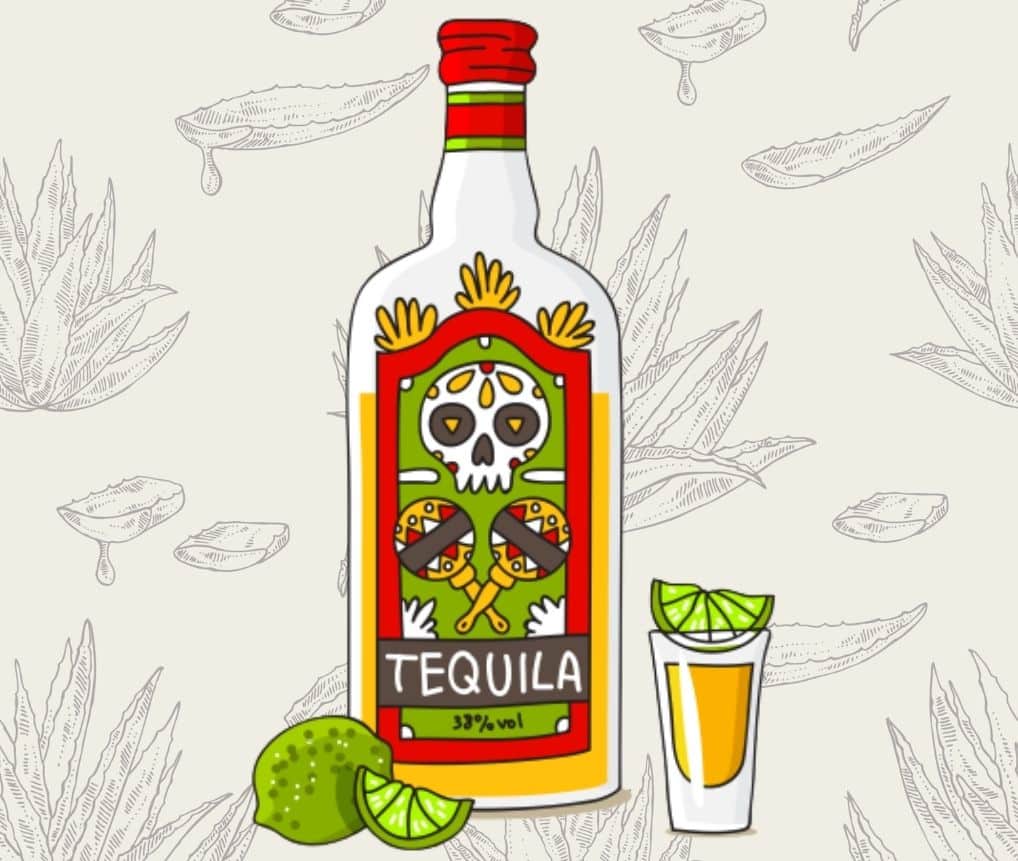
History
Tequila was derived from a drink made by the Aztecs called “pulque.” It was a thick, milky beverage made from fermented sap from agave plants. When European colonists made contact with the drink, they started to distill it to preserve it for long voyages.
The Mexican government declared ownership of tequila as intellectual property in the seventies and set up rules regarding its origin and production.
How it’s made
Only liquor made from the blue agave that grows in the volcanic soil around Santiago de Tequila can classify as real, 100% tequila. Only 300 million agave plants are harvested annually to provide for the entire global market of Tequila.
This means that most popular tequila brands aren’t tequila at all. Brands distill a liquor of 51% agave (not blue agave) and add cane spirit and flavorants. If this is your only experience with tequila, there’s a whole world of spirits out there for you to try.
Jimadors, the people who grow, tend to and harvest the blue agave, trim any leaves and stalks away from the piñas, the fleshy core of the plant. The piñas are then gathered and slowly roasted in a large oven to break down the cores.
The roasted cores are then mashed and left in water for a week to ferment. Once it has fermented, the mix is strained and distilled twice. Silver tequila, primarily used for tequila cocktails, is bottled immediately after distillation.
Anejo tequila is left to age in wooden barrels. This is where it picks up its amber hue which also results in a deeper flavor.
A popular misconception about tequila is that you’ll find a worm, or “lollipop”, floating at the bottom of the bottle. The worm is the larva of a moth that lives in the agave plant, called maguey worms or gusano.
Gusano is found in some bottles of Mezcal, not tequila. These bottles are labeled “con gusano.”
Mezcal is similar to tequila in that it’s a liquor made of agave. But it’s not made from only blue agave and can be made in many different regions.
Liquor or Liqueur?
Liquor and Liqueur are often confused. In fact, they share more similarities than just their names.
All liqueurs are liquor, not all liquors are liqueurs.
This is because liqueurs are all distilled spirits. Liquors often form the base of a liqueur. Whiskey, brandy, or rum is distilled before flavors and sweeteners are added.
Southern Comfort, for example, is a brand of whiskey liqueur. Brewers add flavors of fruit and spice as well as sweeteners to change the original whiskey flavor of the drink.
The added ingredients dilute the spirit and lower its alcohol content. Because of this, most liqueurs are only about half as strong as their liquor counterparts.
Many popular liqueurs have been brewed for centuries, such as Grand Mariner and Amaretti. Some names refer to a type or style of liqueur, like schnapps, where others are brand names with specific recipes, like Amarula.
It’s important to note that fortified wines like sherry or port are not liqueurs. This is because while they have similar alcohol contents, they did not go through distillation.
Liqueurs are often enjoyed as after-dinner treats or aperitifs.
Conclusion
When it comes to picking a liquor to drink, you’re spoiled for choice. For every type of liquor, there are several different styles. For each style, you’re bound to find hundreds of distillers each making their own, unique brew.
We’ve covered only the most popular types of liquor in this list, but there are plenty more options to choose from. Who knows, someone could invent a new one tomorrow.
Now go learn about the proof system in alcohol to further your eductation.

